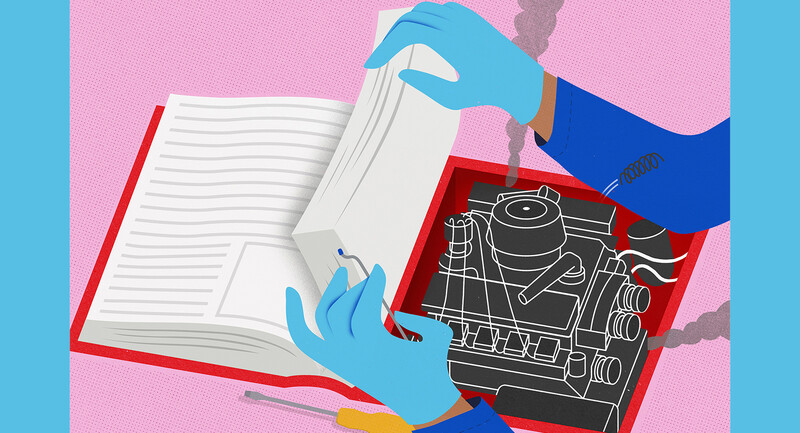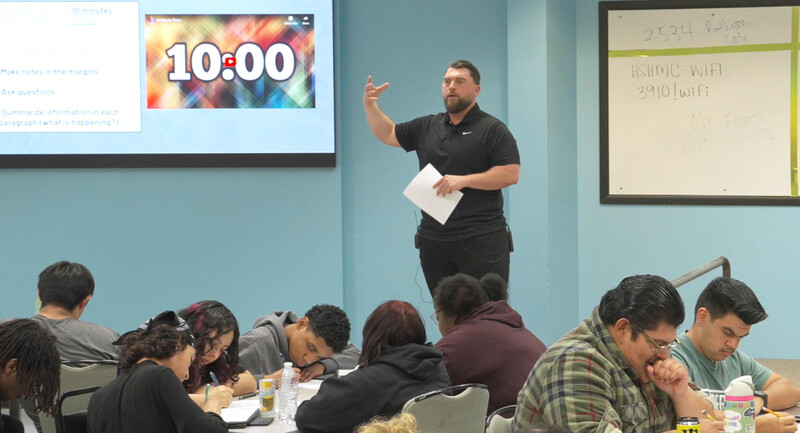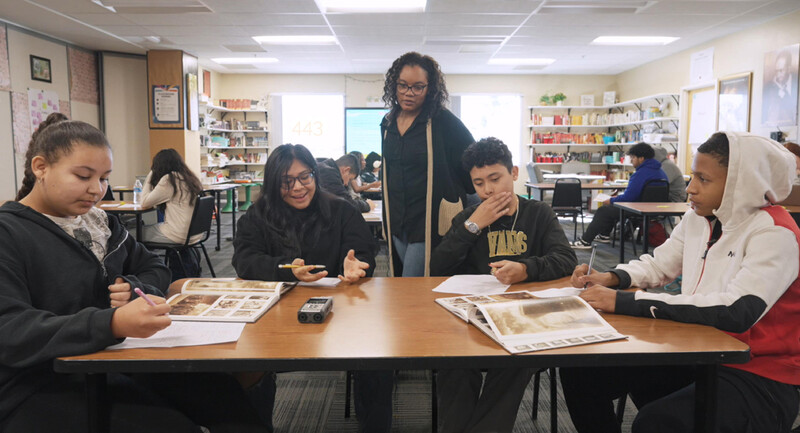"Yes, this multiple intelligences stuff is great, but when do you stop doing the fun stuff and begin teaching my child the basics?" Five years ago, dozens of parents in my small, rural elementary school might have asked this question. Slow to accept new ideas and change, they saw Howard Gardner's theory of varying human intelligences as a light and fluffy educational fad.
Today, however, these same people realize how wrong these perceptions were. In the five years since we began putting Gardner's theory into practice, the overall achievement and confidence of our students have risen substantially. The results have far exceeded our expectations.
We introduced multiple intelligences as a response to a statewide test—the Maryland School Performance Assessment Program. Like the staffs of other public schools in the state, we were now accountable for student achievement on a set of rigorous performance assessments—in reading, math, science, writing, and social studies. Unlike the standardized tests of the past, these assessments required our students to apply basic skills to solve difficult, real-life problems. We immediately realized that if our students were to do well on these assessments, we would have to change our teaching practices.
Whys and Hows of Change
Multiple intelligences theory, as well as Dimensions of Learning and portfolio assessment, became part of our plan for change. As the Instructional Facilitator, my job was to implement these strategies. I began the planning process with a small group of interested teachers.
Gardner's theory reflected what we already knew about our students—each had a different set of strengths and talents. We recognized, however, that using this approach would have to boost student achievement on both the state's alternative assessments and on more traditional tests. Otherwise, parents would see multiple intelligences as a lowering of standards. We also needed to clarify our reasons for adopting this strategy, and we had to establish sound, defensible teaching and assessment practices.
- To help students understand their abilities and those of others.
- To show students how to use their strengths both to learn and to work on their weaknesses.
- To build students' confidence so they would be willing to take educational risks.
- To help students learn more by providing "unforgettable learning" experiences (Kovalik 1994), that is, those that engage so many senses they will never be forgotten.
- To more accurately assess students' mastery of basic skills and higher-level content.
Persuading Parents and Teachers
Because we knew that parents would be most interested in how this approach helped their children learn skills and content, we highlighted that purpose in our discussions with parents. We asked them to think about their own school years and how they were taught. We then asked them to think about a time when they had trouble learning a skill and how using one of their strong "intelligences" might have helped. Most parents came up with at least one example. Many said they used their strong intelligences on their jobs. Having made this connection, they began to see the importance of using various intelligences to learn new skills.
Parents weren't the only ones who needed to be convinced of the value of this approach. Some wondered whether the extra planning time for each intelligence—activities involving music, movement, group work, and so forth—would truly boost student achievement. We had to show these teachers positive results.
Unforgettable Learning
We began by teaching our students about the theory of multiple intelligences. Because I work with almost all the children, I took the lead, allowing them to assess and test their own intelligences through surveys and other activities. The classroom teachers then asked their students to think about which intelligences they were using during different activities.
The results were encouraging. Students not only began referring to their own intelligences, but to those of classmates: "William," I heard one 2nd grader say, "You're using your linguistic skills real good." The children began to understand that they could use their strong intelligences to help improve their weak intelligences. "I'm not so good in my logical-mathematical intelligence," said one young man, "but I am strong in my visual intelligence. So, I draw pictures and diagrams when I do math."
Most important, students were retaining more knowledge. For example, a group of 5th graders who had created their own businesses in class the year before could quickly and accurately explain the effect of economic principles such as supply and demand. Students who in the 3rd grade had created a display about Native Americans knew how to use the concepts of area and perimeter throughout their school years. All this "unforgettable learning" involved a number of the different intelligences. And as teachers saw the results, many jumped on the bandwagon.
Once we taught our students about their different abilities, we began to include different intelligences in each of our lessons. One teacher taught multiplication tables using the African-American tradition of "ham bone," a chant accompanied by rhythmic knee slapping. She found that students who had trouble remembering their math facts were able to recall the multiplication tables quite easily. Furthermore, the students enjoyed practicing their tables.
Other teachers allowed students to decide how they would learn, process, and display their knowledge. One 5th grade class, for example, created a school museum of famous people. To gather information about the person they chose, some students watched videotapes, others used the Internet, and still others read books. Given a choice, the children seemed more willing and able to do the research.
The students also had a range of options in compiling the information. They were not required to take notes or to write reports. If they preferred, they could use graphic organizers, mind maps (Buzan 1983), or tape recorders instead. Their teacher then asked them to select three intelligences to display their knowledge. Surprisingly, many students who regularly complained about writing chose to write a report when given other options.
In general, students became more self-directed and seemed more confident in trying out new skills. Some discovered abilities they never knew they had. One usually quiet 5th grader spoke fluently about his famous person. Another child found that she enjoyed acting.
Aiming High
- How can we make sure students have the skills they need to prepare quality products that call for visual, bodily-kinesthetic, interpersonal, and musical intelligences?
- How can we set reasonable yet rigorous standards for these products?
- How can we help our students complete the state assessments successfully?
We approached the first issue by brainstorming the skills students would need to produce quality products in art, drama, and music, and to excel in physical education. In considering the interpersonal skills students would need, we consulted books and articles on cooperative learning. We asked the arts specialists in our school and community to join us in the brainstorming exercise. In some cases, they not only helped us identify the needed skills but also suggested lessons or drills to teach those skills.
These specialists helped us set standards for evaluating student projects in the visual and performing arts. Our teachers were quite comfortable evaluating traditional written work, but less assured about evaluating plays, songs, paintings, and so on. As a result, standards were often lower in these areas. The specialists helped us realize that we needed to be as rigorous in grading artwork and oral performances as we were in evaluating a written paragraph or a mathematical solution. In the real world, after all, fields in the arts are highly competitive.
Our students already understood why tough standards are important. Two 4th grade classes, for example, created games for learning about math processes. The students discussed the characteristics of games they enjoyed playing and the reasons they found other games boring. They were very demanding. As one student said, "If a game isn't any good, no one's going to buy it!"
Once our students knew that we expected quality work, they became more skilled in their crafts. They also internalized these high standards and applied them to all of their work, resulting in across-the-board improvement in coursework.
Test-Taking Technique
To help our students perform well on the more traditional state assessments, we used several strategies.
One approach was to allow students to pair their chosen method of displaying knowledge with more traditional pen-and-pencil tests. For example, in a unit on wetlands, 2nd graders created models of wetland environments and wrote explanations of what their models showed. In this way, they developed both a framework for writing and confidence in their knowledge. When the time came to write about wetlands, they didn't have to struggle with what to say—their models reminded them.
We also prepared our students for the strict time limits on the state assessments. We gave them a menu of thought organizers and test-taking strategies that would appeal to their different intelligences. The thought organizers ranged from graphic organizers, mind maps, and time lines to silly mnemonic songs. We taught selective highlighting and underlining of important words in test directions, jump-starting answers with words from the questions, and time management techniques. We even suggested exercise breaks they might use during long tasks.
Our preparation paid off. In one year, our students' scores on the Maryland School Performance Assessment rose by 20 percent. They remembered information more accurately and were confident enough to use it to solve problems. They did well at completing graphs and worked easily with manipulatives. They worked well in groups engaging in hands-on experiments. They demonstrated a flexible approach to problem solving. They were taking traditional pencil-and-paper tests, but using a variety of strategies to complete them. Even students whom we did not consider strong readers or writers were able to use the strategies we taught to write good answers.
Most striking was the students' confidence that they could do a good job on these tests; they were neither intimidated nor tense. They saw the tests as a chance to share their knowledge with others.
Success Sells
This progress has continued. Teachers who were afraid to include multiple intelligences in their repertoire are now adding it to their many teaching tools. Parents now see that innovation need not mean moving away from the basics. Most important, our students now see themselves as individuals who have a variety of talents they can use in their learning. In sum, we have created a new school culture—one that values excellence, diversity, and achievement.







